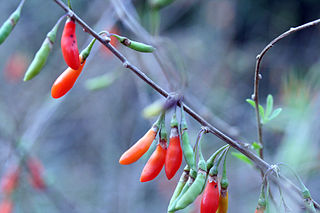
Lycium chinense is one of two species of boxthorn shrub in the family Solanaceae. Along with Lycium barbarum, it produces the goji berry ("wolfberry"). Two varieties are recognized, L. chinense var. chinense and L. chinense var. potaninii. It is also known as Chinese boxthorn, Chinese matrimony-vine, Chinese teaplant, Chinese wolfberry, wolfberry, and Chinese desert-thorn.

Pulmonaria longifolia, is a semi-evergreen clump-forming herbaceous perennial plant, native to western Europe, including Britain, France, Spain, Portugal. It grows in semi-shaded habitats, such as woodland and scrub, to 2000 m above sea level.

Antirrhinum majus, the common snapdragon, is a species of flowering plant belonging to the genus Antirrhinum. The plant was placed in the family Plantaginaceae following a revision of its prior classical family, Scrophulariaceae.

Brunfelsia pauciflora is a species of flowering plant in the family Solanaceae, the nightshades. It is endemic to Brazil, and it is grown in cultivation. A shrubby perennial plant grown in gardens, its common names include today, tomorrow together, morning-noon-and-night, kiss me quick, and Brazil raintree.

Potentilla recta, the sulphur cinquefoil or rough-fruited cinquefoil, is a species of cinquefoil. It is native to Eurasia but it is present in North America as an introduced species, ranging through almost the entire continent except the northernmost part of Canada and Alaska.

Euphorbia prostrata is a species of spurge known by the common name prostrate spurge or prostrate sandmat.
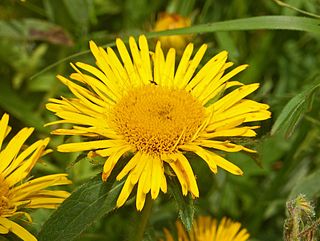
Pentanema hirtum is a species of perennial herbaceous plant belonging to the family Asteraceae. The specific Latin name hirtum refers to the type of hairiness of the plant.

Lithospermum purpurocaeruleum, the purple gromwell, is a herbaceous perennial rhizomatous plant of the genus Lithospermum, belonging to the family Boraginaceae.
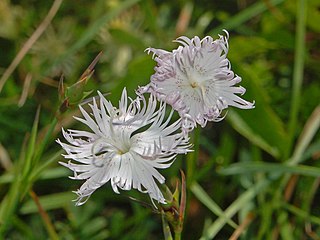
Dianthus monspessulanus, the fringed pink, is a herbaceous perennial plant of the genus Dianthus of the family Caryophyllaceae. The genus name Dianthus derives from the Greek words for divine ("dios") and flower ("anthos"), while the species name monspessulanus means "from Montpellier".

Stachys recta, commonly known as stiff hedgenettle or perennial yellow-woundwort, is herbaceous perennial plant of the family Lamiaceae.

Iberis umbellata, common name garden candytuft or globe candytuft, is a herbaceous annual flowering plant of the genus Iberis and the family Brassicaceae.

Solanum chilense is a plant species from the "tomato" subgenus Lycopersicon within the nightshade genus Solanum.
Solanum arcanum is a species of nightshade, commonly called the "wild tomato," endemic to Peru.

Pedicularis verticillata, the whorled lousewort, is a species of flowering plant in the family Orobanchaceae which can be found in Alaska, North-Western Canada, and everywhere in China at the elevation of 2,100–4,400 metres (6,900–14,400 ft). Its native habitats include moist meadows and lakeshores.

Coronilla minima is a species of flowering plant from the family Fabaceae found in Eastern and Central Spain.
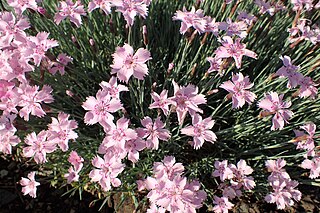
Dianthus plumarius, also known as the common pink, garden pink, or wild pink, or simply pink, is a species of flowering plant in the family Caryophyllaceae.
Primula hookeri is a perennial species of primrose which is found at the altitudes of 3,900–5,000 metres (12,800–16,400 ft) in Eastern Himalayas as well as in Bhutan, Myanmar, Nepal, Northeast India and southeastern Tibet and northwestern Yunnan provinces of China.

Hypericum elodeoides, commonly called the Himalayan St. John's Wort, is a species of flowering plant of the St. John's wort family (Hypericaceae).
Cyananthus formusus is a species of perennial flowering plant in the family Campanulaceae. It is native to grassy slopes and forests of northwest Yunnan in China. In Mandarin the species is known as 美丽蓝钟花. Originally described by Ludwig Diels in 1912 in the Notes of the Royal Botanical Garden Edinburgh, the species is a small, blue-flowered plant suitable for Alpine gardens.
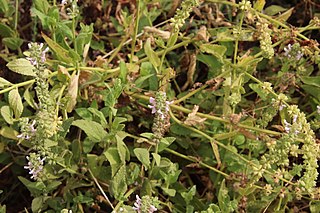
Stachys stebbinsii is a species of perennial herb in the mint family commonly known as Stebbins' hedgenettle. This plant is characterized by a musky aroma, flowers with large lower lips, and glandular hairs that densely cover the stems. S. stebbinsii is native to California and northwestern Baja California. It is usually found growing in moist places in a wide variety of habitats including disturbed areas, chaparral, coastal sage scrub and mountains.


















